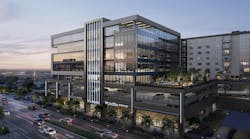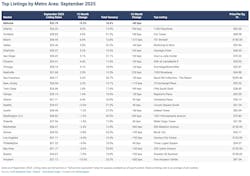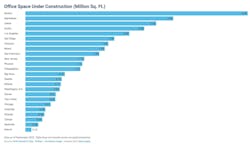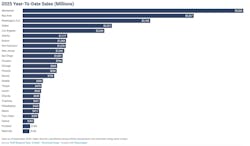Updated report finds office demand and construction still modest
For all the hand wringing about the fate of office spaces, there was nearly as much square footage of office construction started in the first nine months of 2025 as for all 12 months of 2024.
That estimate comes from CommercialCafe’s recently released National Office Report for October. Through September 2025, there were 11.9 million sf of office starts, compared to 12.1 million sf for the full year in 2024 (which, admittedly, was a 10-year low). CommercialCafe, drawing on Yardi Research data, also tracked nearly 2,000 transactions for buildings 25,000 sf or larger that, through September, generated nearly $38 billion in office sales, the highest year-to-date total since 2022.
Office demand, though, remains relatively soft, as the national vacancy rate for September stood at 18.6%, only slightly down from the previous year. CommercialCafe also observes a “modest” supply pipeline of 38 million sf of office space at various stages of construction.
Unmet demand for highly amenitized assets in key markets continues to push projects forward, despite vacancy rates still appearing uncomfortably high. “We anticipate an uptick in new, best-in-class office construction to meet the demand for premier spaces. The expectation will be smaller ‘jewel box’ buildings rather than the trophy towers of the past. Notably, New York City is the main exclusion of this apparent trend,” states Peter Kolaczynski, Director, Yardi Research, in the Report.
In addition, the continued importance of flexibility sustains the growing relevance of the coworking segment, which continues to steadily increase its share of the U.S. office market.
Vacancies highest in the West
CommercialCafe states that Nashville had the highest increase in office vacancy rate among major metros: a 2.2 percentage point jump to 19.5%. This year so far, developers have delivered 1.4. million sf of new office space in Nashville, which currently has only 300,000 sf under construction.
Conversely, Miami showed the steeping decline in its vacancy rate, by 2.1 percentage points to 12.8%.
The relationship between construction activity and vacancy rates, however, can sometimes seem counterintuitive. For example, the Report states that despite a vacancy rate that exceeds 20%, Dallas-Fort Worth surpassed 1 million sf in starts through September. CommercialCafe states that in DFW, mixed-use projects with retail and residential components are driving office construction activities.
Boston, with a relatively low 15.4% vacancy rate, remains the country’s most active office builder, with 4.45 million sf of office space under construction. Manhattan ranks second, at 2.96 million sf, but leads the country in office sales, at more than $5.5 billion through September. (Manhattan’s vacancy rate is also around 13%.)
Vacancy rates in the West continued to exceed the national average, led by Seattle, at 27%, and San Francisco, at 26.7%.
With exceptions like Chicago and Detroit, Midwest markets tracked by CommercialCafe remained below the national vacancy average.
Office-using job growth stagnant
The future of office space will depend on job growth in office-using sectors. On that front, the information is mixed.
According to Yardi Research analysis of private sector data sources, office-using employment sectors recorded a modest 0.7% increase year-over-year last month. However, Automatic Data Processing, Inc. estimates found that even as the Information sector gained 3,000 jobs last month, there was a combined loss of 19,000 jobs in the month of September, led by the Professional and Business Services sector, as well as the Financial Activities sector.
Bureau of Labor Statistics data at the metropolitan level showed that 17 of the top 25 markets saw year-over-year decreases in jobs as of August. Among the few large markets where that was not the case, Charlotte, N.C., and Philadelphia showed the largest gains: Professional and Business Services accounted for a 1.5% employment growth in Philadelphia, which led major U.S. cities with the largest increase in bachelor’s degree-holders from 2020 to 2021. Its 155% rise translated to a large pool of professional talent that firms can tap into.
About the Author

John Caulfield
John Caulfield is Senior Editor with Building Design + Construction Magazine.



